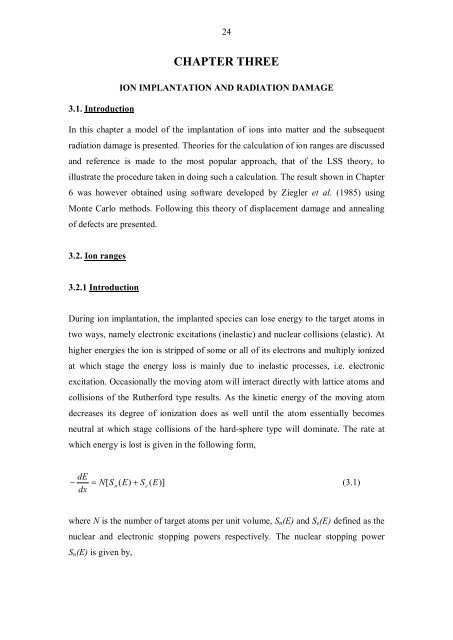Analysis of the extended defects in 3C-SiC.pdf - Nelson Mandela ...
Analysis of the extended defects in 3C-SiC.pdf - Nelson Mandela ...
Analysis of the extended defects in 3C-SiC.pdf - Nelson Mandela ...
You also want an ePaper? Increase the reach of your titles
YUMPU automatically turns print PDFs into web optimized ePapers that Google loves.
3.1. Introduction<br />
24<br />
CHAPTER THREE<br />
ION IMPLANTATION AND RADIATION DAMAGE<br />
In this chapter a model <strong>of</strong> <strong>the</strong> implantation <strong>of</strong> ions <strong>in</strong>to matter and <strong>the</strong> subsequent<br />
radiation damage is presented. Theories for <strong>the</strong> calculation <strong>of</strong> ion ranges are discussed<br />
and reference is made to <strong>the</strong> most popular approach, that <strong>of</strong> <strong>the</strong> LSS <strong>the</strong>ory, to<br />
illustrate <strong>the</strong> procedure taken <strong>in</strong> do<strong>in</strong>g such a calculation. The result shown <strong>in</strong> Chapter<br />
6 was however obta<strong>in</strong>ed us<strong>in</strong>g s<strong>of</strong>tware developed by Ziegler et al. (1985) us<strong>in</strong>g<br />
Monte Carlo methods. Follow<strong>in</strong>g this <strong>the</strong>ory <strong>of</strong> displacement damage and anneal<strong>in</strong>g<br />
<strong>of</strong> <strong>defects</strong> are presented.<br />
3.2. Ion ranges<br />
3.2.1 Introduction<br />
Dur<strong>in</strong>g ion implantation, <strong>the</strong> implanted species can lose energy to <strong>the</strong> target atoms <strong>in</strong><br />
two ways, namely electronic excitations (<strong>in</strong>elastic) and nuclear collisions (elastic). At<br />
higher energies <strong>the</strong> ion is stripped <strong>of</strong> some or all <strong>of</strong> its electrons and multiply ionized<br />
at which stage <strong>the</strong> energy loss is ma<strong>in</strong>ly due to <strong>in</strong>elastic processes, i.e. electronic<br />
excitation. Occasionally <strong>the</strong> mov<strong>in</strong>g atom will <strong>in</strong>teract directly with lattice atoms and<br />
collisions <strong>of</strong> <strong>the</strong> Ru<strong>the</strong>rford type results. As <strong>the</strong> k<strong>in</strong>etic energy <strong>of</strong> <strong>the</strong> mov<strong>in</strong>g atom<br />
decreases its degree <strong>of</strong> ionization does as well until <strong>the</strong> atom essentially becomes<br />
neutral at which stage collisions <strong>of</strong> <strong>the</strong> hard-sphere type will dom<strong>in</strong>ate. The rate at<br />
which energy is lost is given <strong>in</strong> <strong>the</strong> follow<strong>in</strong>g form,<br />
dE<br />
N[<br />
S n ( E)<br />
Se<br />
( E)]<br />
(3.1)<br />
dx<br />
where N is <strong>the</strong> number <strong>of</strong> target atoms per unit volume, Sn(E) and Se(E) def<strong>in</strong>ed as <strong>the</strong><br />
nuclear and electronic stopp<strong>in</strong>g powers respectively. The nuclear stopp<strong>in</strong>g power<br />
Sn(E) is given by,

















